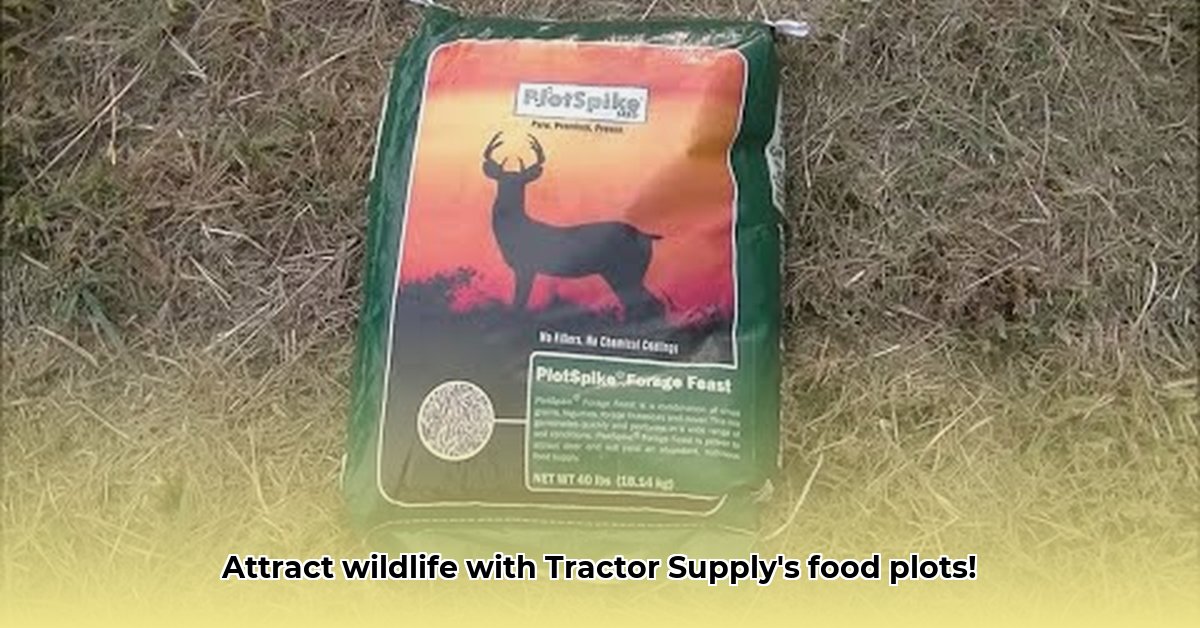
Food Plot Mixes: A Wildlife Haven in Your Backyard
Want to attract more wildlife to your property? Enhancing your land's biodiversity is achievable, and Tractor Supply's food plot mixes offer a readily available tool. But how effective are these mixes? Let's explore how to use them effectively and responsibly, understanding both their potential and limitations. This comprehensive guide will help you create a thriving wildlife habitat while considering sustainable practices. For raised bed options, check out these resources.
Understanding Tractor Supply's Offerings: More Than Just Seeds
Tractor Supply provides a variety of food plot mixes, blends of seeds designed to attract specific animals, such as deer. While the popularity of these mixes signals a growing interest in wildlife enhancement, the available data on their overall effectiveness is limited. More research is needed to confirm long-term benefits and potential drawbacks. However, the demand for these products indicates a clear need for further information and best practices. This guide aims to provide that guidance.
Choosing the Right Mix: A Personalized Approach
Selecting the ideal food plot mix requires thoughtful consideration. Think of it as crafting a tailored recipe for your wildlife "guests":
- Target Wildlife: Deer? Turkeys? Different animals prefer different plants. Choosing a mix that aligns with their dietary preferences is crucial for success.
- Soil Analysis: Before planting, conduct a soil test. Soil type and pH significantly impact seed germination and growth. Matching the mix to your soil conditions maximizes your chances of a thriving plot.
- Budgeting: Food plot mixes vary in price. Determine your budget and the area you intend to plant. Start small, test different mixes, and gradually expand your efforts.
- Time Commitment: Some mixes require more maintenance than others. Assess your available time for watering, weeding, and pest control before making a decision.
Planting for Success: A Step-by-Step Guide
Growing a successful food plot involves a multi-step process:
- Soil Assessment: Your soil test results guide necessary adjustments to optimize growing conditions.
- Ground Preparation: Clear weeds, till the soil (unless using a no-till method, see below), and remove debris to create a suitable seedbed.
- Precise Planting: Adhere strictly to the seed package instructions regarding planting depth, spacing, and recommended techniques.
- Ongoing Maintenance: Monitor for pests and diseases, providing fertilizer as needed to support plant growth throughout the growing season.
- Long-Term Planning: Consider crop rotation to prevent soil depletion and pest build-up.
Sustainable Wildlife Management: A Balancing Act
While food plots offer significant benefits, potential drawbacks require careful consideration:
Advantages:
- Enhanced Wildlife Habitat: Food plots provide crucial nutrition, attracting more diverse and abundant wildlife.
- Biodiversity Support: Attracting insects and other creatures that subsequently become food for other animals creates a cascading effect, supporting overall ecosystem health.
- Hunting Opportunities (where applicable): Successful food plots can increase hunting opportunities, contributing to wildlife management programs.
Disadvantages:
- Ecological Imbalances: Uncontrolled food plots could create imbalances within the local ecosystem, leading to overpopulation of certain species and negatively impacting others.
- Environmental Concerns: The production and transportation of commercial mixes have an environmental footprint. Selecting sustainably produced mixes (locally sourced seeds, minimal packaging) can reduce this impact.
- Uncertain Long-Term Effects: The long-term effects of widespread food plot use require further research to fully understand potential consequences.
No-Till Food Plots: A Sustainable Approach
No-till food plots offer a more environmentally friendly approach. These plots are established without plowing or tilling, preserving soil structure, improving water retention, and reducing erosion. This method promotes soil health, leading to better plant growth and attracting wildlife while minimizing environmental disturbance. Implementing no-till requires careful weed management and might necessitate specialized planting equipment initially.
Research Gaps and Future Directions
While promising, several knowledge gaps remain:
- Comparative Mix Effectiveness: More research is needed to compare the effectiveness of different mixes in attracting wildlife and providing nutritional value.
- Long-Term Environmental Impacts: Long-term studies are necessary to assess the effects on soil health, water quality, and biodiversity.
- Integration with Sustainable Agriculture: Further investigation is needed to understand how food plots can be integrated into larger sustainable agricultural practices.
Creating a wildlife haven requires careful planning, responsible management, and a commitment to sustainability. By combining careful preparation with an understanding of potential impacts, we can create a thriving landscape that benefits both wildlife and humans.